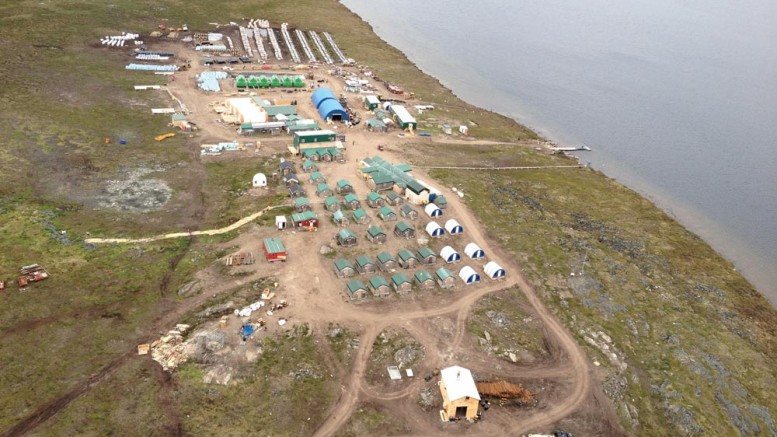VANCOUVER — The future of Sabina Gold and Silver’s (TSX: SBB; US-OTC: SGSVF) promising Back River gold property, 400 km southwest of the community of Cambridge Bay in Nunavut, has come into question after a decision by the Nunavut Impact Review Board (NIRB) that recommends delaying permits until “circumstances are more favourable, and uncertainty regarding potential effects and efficacy of mitigation measures has been established.”
In a report that runs 350 pages the regulatory agency cited a number of concerns with the Back River mine plan, but the major issues surround regional caribou populations, closure uncertainties related to climate change and tailings remediation.
Sabina president and CEO Bruce McLeod called the decision “surprising and disappointing” during a conference call, and said the report didn’t seem to represent the positive tone of recent public hearings.
The company had anticipated a project certificate from the Minister of Aboriginal Affairs and Northern Development Canada during the second quarter, which would have led to construction start-up in late 2017 and first gold by 2020.

The Back River gold project 520 km northeast of Yellowknife, Northwest Territories. Credit: Sabina Gold & Silver.
McLeod noted that the NIRB “clearly opened the door for resubmission and modification,” but said there was “no timeline” on the process. The company says the permit setback could delay construction at Back River by at least one year due to “seasonality.”
The decision indeed seems odd since Back River appeared to enjoy support from stakeholders. The Kitikmeot Inuit Association also championed the project, while the governments of Nunavut and the Northwest Territories suggested that Sabina’s final environmental impact statement warranted development permits.
Nunavut has become a relatively low-risk permit jurisdiction in Canada, with Agnico Eagle Mines (TSX: AEM; NYSE: AEM) operating the Meadowbank gold mine, and TMAC Resources (TSX: TMR; US-OTC: TMMFF) receiving NIRB approval for development of its Doris North project in the Kitikmeot region, 125 km southwest of Cambridge Bay and east of the Bathurst Inlet.
The NIRB added that “many of the preferred means of carrying out [the project] chosen by [the company], such as tailings disposal and impoundment measures, are based on methods and technologies widely used in other northern mines.”
It appears that Sabina suffered from Back River’s location, however, and its closeness to the migration route of the Bathurst caribou herd, which the Northwest Territories government says has halved since 2012 to 16,000 animals.

Wildlife in the Back River region of southwestern Nunavut. Credit: Sabina Gold and Silver.

Worker sampling in the field near Back River. Credit: Sabina Gold and Silver.
Sabina noted in its research that the Bathurst caribou range hadn’t overlapped the project area in “over 20 years,” but the NIRB regulators cited speculation that it could swing back to the area at some point.
Interestingly, the issue has a transboundary component due to the opposition of communities in the Northwest Territories — specifically the Lutsel K’e Dene and Yellowknives Dene First Nations.
Under the provisions of the Nunavut Land Claims Agreement, the next step is for the federal Minister of Indigenous and Northern Affairs to review the NIRB’s report. Sabina is reportedly “reviewing its options,” including a request to the Minister to refer the report back to NIRB for further consideration.
On June 16, McLeod sent a letter to Minister Carolyn Bennett requesting she “defer any decision in response to the report until [the company] has time to review it in detail.”
In September 2015 Sabina released a revised feasibility study at Back River that models a compact 3,000-tonne-per-day operation that would generate 198,100 oz. gold annually over an 11.8-year mine life, at all-in sustaining cash costs of US$763 per ounce.
Initial capital for the project is an estimated $415 million, with sustaining capital of $185 million. Based on a US$1,150 per oz. gold price, the mine would generate a US$480-million, after-tax net present value at a 5% discount rate, and a 24.2% internal rate of return.

Back River lies 400 km southwest of the community of Cambridge Bay, Nunavut. Credit: Sabina Gold and Silver.
Canaccord Genuity analyst Eric Zaunscherb noted that transcripts of the final public hearing for the environmental assessment “suggested a positive and supportive tone from stakeholders,” while documents indicated “that the current Bathurst herd caribou calving and post-calving ranges do not overlap the project development area.”
Zaunscherb said Back River would “eventually become a mine,” but Canaccord dropped Sabina’s target price 75¢ to $1 per share, pushed project start-up back two years and added $50 million to capital expenses to “cover additional remediation efforts and the expected increase in equipment and services costs through the cycle.” Zaunscherb also called the setback “surprising” and noted that NIRB based the decision on “several hypothetical issues.”
Sabina has traded within a 52-week range of 31¢ to $1.87, and dropped nearly 40%, or 66¢, after news of the NIRB decision en route to a $1.06-per-share close at press time. The company has 220 million shares outstanding for a $152.3-million market capitalization, and closed a $32.3-million bought-deal financing in late May, wherein it issued 19.8 million shares priced at $1.63 per share.


Be the first to comment on "Sabina suffers permit setback at Back River"